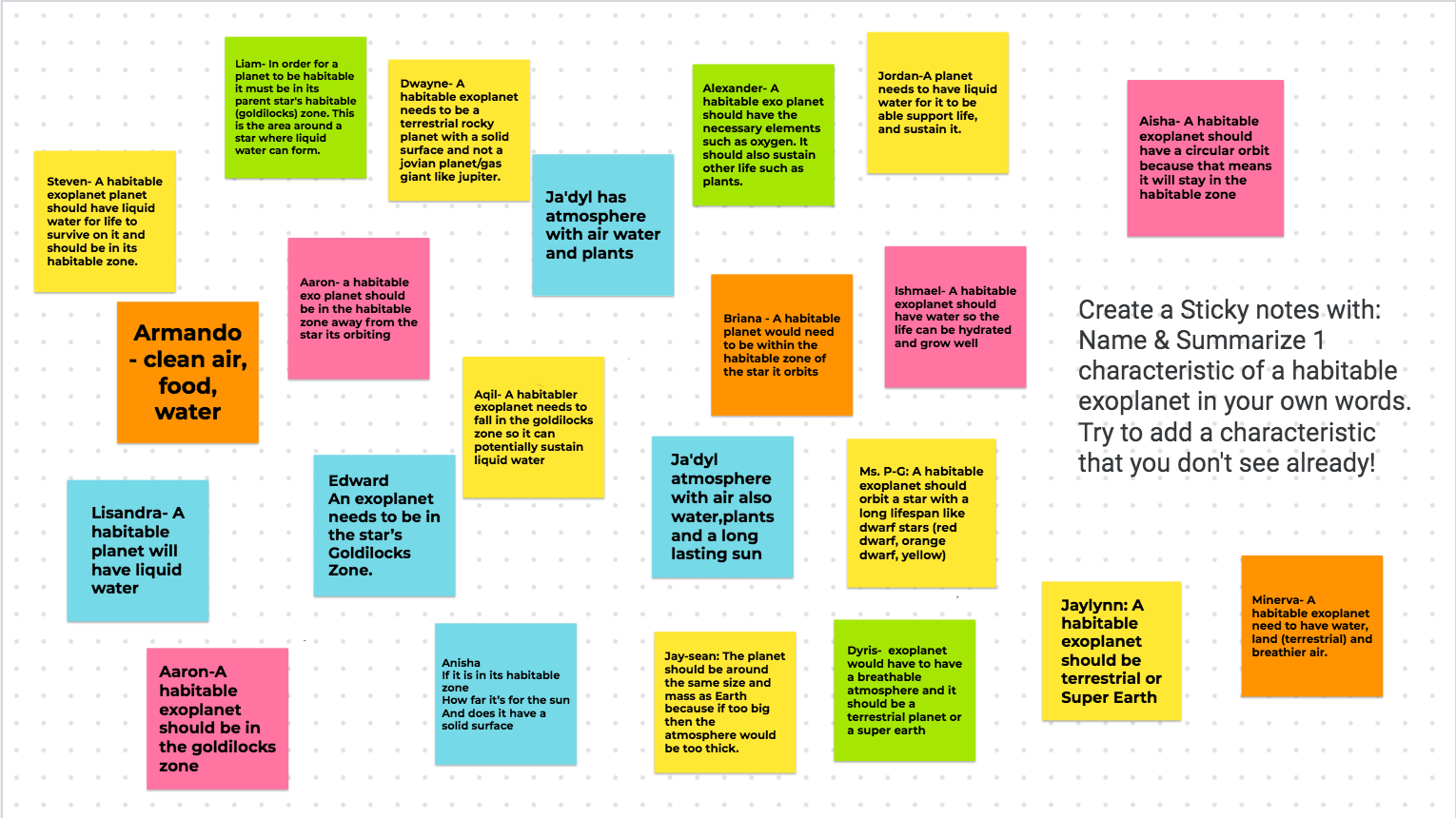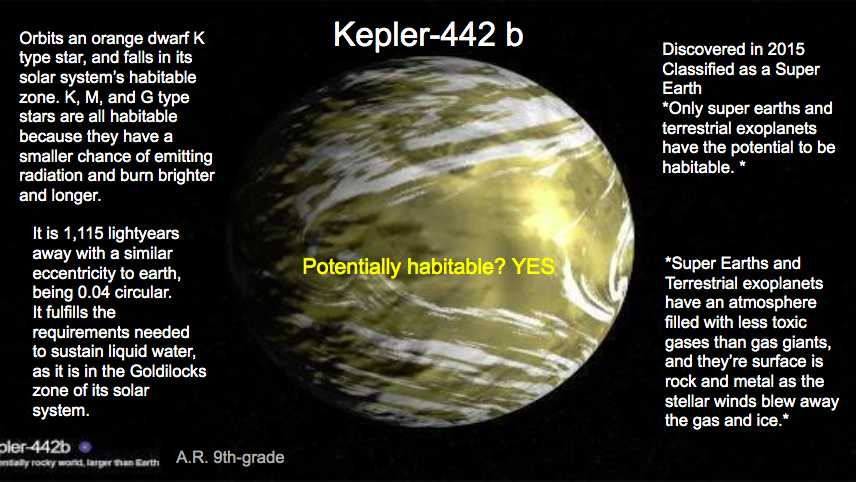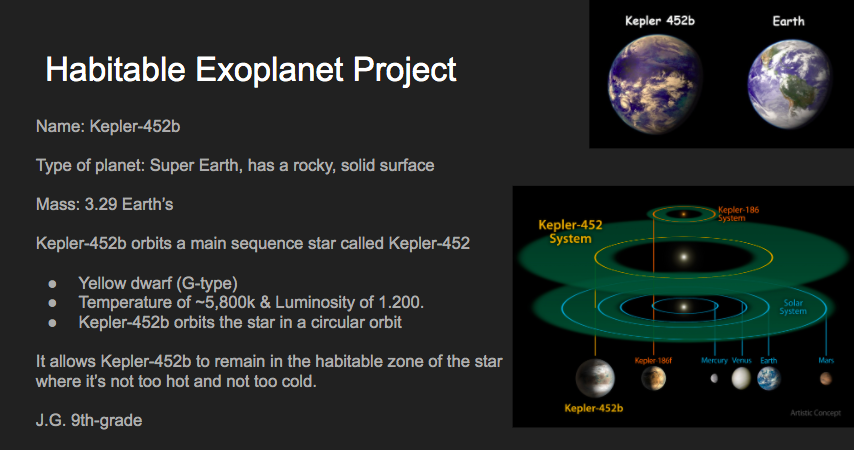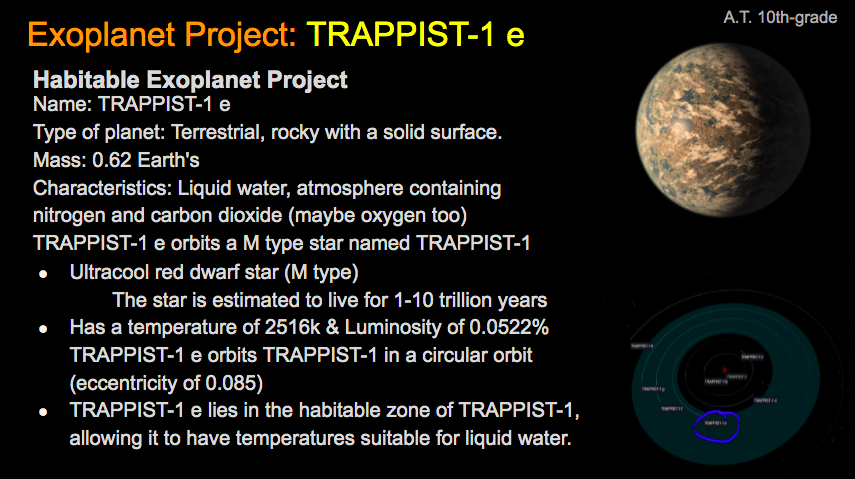feature
Got Covid-19 Cabin Fever?
Journey through space in search of habitable alien worlds from wherever you learn
The Science Teacher—January/February 2022 (Volume 89, Issue 3)
By Ariadne Prior-Grosch and Karen Woodruff

Fall 2020 presented myriad challenges for teachers trying to plan curricula to meet students’ social-emotional and learning needs following an unprecedented spring and summer of isolation and loss due to the pandemic caused by SARS-CoV-2 (Rivera and Wallace 2020). The result of creative planning and adjusting of curricula for remote instruction led to a new component of thinking about differentiation: Beyond differentiating to students in the classroom, teachers were and continue to differentiate to students in different learning environments. The following unit is an example of how I reimagined my Earth and Space Science class for ninth- and tenth-grade students for remote instruction that included strong data analysis and critical-thinking components.
As written, the unit emphasizes building a strong classroom community online, creates opportunities for students to follow their own curiosity, and teaches transferable skills—specifically argumentative writing skills—that will support students’ success across subject areas. At the time I designed the unit, I was also collaborating with a network of colleagues from the Endeavor STEM Teaching Certificate Project where teachers share ideas and collaborate. This professional collaboration and my dedication to meeting my students’ needs led me to design a unit that took my students on a journey that was out of this world (science pun intended!).
Habitable exoplanets as the anchoring phenomenon
Astronomy offers exciting advances in exoplanet research and there are many tools and visualizations that are accessible digitally. Astronomy topics have the unique potential to inspire wonder in learners young and old. Tomlinson (2011) asserts that teaching astronomy not only helps students develop scientific literacy skills but may also inspire them to pursue a STEM career later on. Additionally, by learning about topics in astronomy related to planet habitability, students develop critical-thinking skills and a deeper appreciation for the uniqueness of Earth and how imperative it is for us to take care of it (Tomlinson 2011). NGSS instruction includes using anchoring phenomena to engage students in driving questions and unpacking evidence through engagement with the three dimensions. The potential of habitable exoplanets excites students and serves as the anchoring phenomenon through which NGSS Disciplinary Core Idea ESS1.A: The Universe and Its Stars, science and engineering practices Engaging in Argument from Evidence and Analyzing and Interpreting Data, and the crosscutting concept of Scale are explored (NGSS Lead States 2013).
In addition to the three dimensions of NGSS, this unit focuses on developing students’ writing skills through a student-directed Claim-Evidence-Reasoning (CER) scaffold. Students demonstrate mastery of the performance expectations by identifying an exoplanet that has a high probability of being habitable because of its characteristics. Synthesizing their new understanding, they make suggestions for further exploration of exoplanets by NASA.
5E unit outline
The unit’s lesson sequence follows the BSCS 5E instruction model (Engage, Explore, Explain, Elaborate, Evaluate) allowing students to construct, refine, and extend their understanding of the major Astronomy content topics (Bybee et al 2006). Students first explore exoplanets using online resources to generate interest, excitement, and questions before diving into the scientific concepts they’ll apply to evaluate the potential habitability of exoplanets.
Engage: Is there another Earth?
Students engage in the exploration of exoplanets by looking at data from NASA’s Kepler mission and viewing videos (see Online Connections, Unit Plan). Prompt them to ask questions about the data and organize their ideas using “sticky notes” on a Google Jamboard. (Jamboard is a great tool for collaboration during virtual instruction and in districts with computer access. This can be done with any brainstorming protocol if computers are not available.) Ask students to think about the data as it relates to life on Earth and what they know of Earth’s unique systems. For example, as the teacher, I prompted students to think about the data by asking the following probing questions: “Why is Earth so special?” “Why are so many different species able to survive on Earth?” “How do nonliving things (abiotic factors) make life possible on Earth?”
Students can work in groups on different Jamboard frames or at tables in a classroom to collect their ideas and share out with the class. Students can be grouped based on student choice, randomly, or homogeneously or heterogeneously based on their self-assessed prior astronomy knowledge in either virtual or in-person learning. At the end of the Engage phase, several student-generated questions about the data drive the unit progression. Examples from my class are:
- How do exoplanets get energy for life?
- Do exoplanets have atmospheres with oxygen?
- Is the gravity on exoplanets the same as on Earth?
- Do exoplanets rotate and revolve as planets in our solar system do, or do they rotate and revolve at different rates?
By studying the data together, students engage in analyzing and interpreting NASA data in the context of understanding what makes Earth unique. This collaborative strategy allows students to work together to make sense of habitability. Those with a strong understanding of the unique characteristics of habitable planets are able to support those who need additional support or are absent from class. The collaborative nature of this engagement activity should be carried throughout the unit. I suggest posting the Jamboards on Google Classroom so students can refer to them as a resource for evidence and reasoning later in the unit when constructing their claims.

Explore: Types of stars and Goldilocks zone
Using a variety of online Edpuzzle videos, Newsela articles, and online simulations, students explore how other stars are similar to or different from Earth’s Sun, how the Sun produces energy, how Earth orbits around the Sun, eccentricity, and the concept of the Goldilocks zone or habitable zone. The Explore component of the 5E lesson planning model is hands-on and minds-on, providing student-directed opportunities for exploration. Independent students may be able to explore resources on their own, while more dependent learners may need scaffolded tasks (see Online Connections, Learning Activity: Strange New Worlds Exploration).
Students view a video called “What If Earth Had a Large Elliptical Orbit?” and discuss how eccentricity affects habitability (see Online Connections, Lesson Plan Explore/Explain 2). Throughout this phase, students apply their knowledge of the differences between stars and make predictions about the stars that would be most suitable to host an Earth-like planet. To achieve this task, students synthesize their knowledge of planetary orbits and the importance of the distance from the host star. This information is used later by students as their evidence and reasoning in their final CER scientific explanation.

Explain: Exoplanets and habitability
In the Explain phase, students learn about the characteristics of different exoplanet types and analyze their potential habitability. Students examine two writing samples containing the same information but written using different writing styles (science and humanities) to identify and explain how the conventions of science writing are different from the conventions of writing in their English and history classes. As a formative assessment, students write a CER to evaluate their understanding of important concepts thus far and their ability to apply the concepts to evaluate exoplanet data. Students make a claim about the types of stars that would be the best candidates for having Earth-like exoplanets orbiting them using the information they collected and synthesized as their evidence and reasoning. Students receive specific feedback on their CER writing, focused on both the scientific accuracy of their ideas and their ability to connect their evidence using scientific reasoning (concepts) to support a clear and detailed claim. Students then use the feedback to improve their CER writing on their summative assessment.
After students have a solid understanding of the criteria of stars, exoplanets, and their orbits that affect habitability, students compare and contrast the properties of Earth’s atmosphere with other atmospheres found in our solar system and beyond to determine the important characteristics of an atmosphere that would make an exoplanet more likely to be habitable.

Elaborate: Exoplanet detection methods and eccentricity
In the Elaborate phase students use the 5 Ways to Find a Planet NASA resource to investigate the different methods that NASA uses to identify exoplanets. Students compare the different detection methods and evaluate the types of information that NASA can learn about individual exoplanets based on the different methods and the pros and cons of each method. Additionally, students synthesize their understanding of habitability criteria by applying the concepts to Earth. Students revisit their initial ideas from the Engage phase in response to the question “Why is Earth so special?” and revise and critique their ideas from the start of the unit. By bringing the unit full circle, students reevaluate the uniqueness of Earth in light of their new understandings and engage in a discussion of why it is so important to protect our planet.
In preparation for the summative assessment, students calculate the orbital eccentricity for Earth and a few potentially habitable exoplanet candidates of their choosing. Students calculate eccentricity using the equation e = f/d, where f is the distance between foci of an ellipse, and d is the ellipse’s major axis length (Kepler’s first law of planetary motion) (HS-ESS1-4). Students create their own data table to display their results and apply the concepts of habitability to interpret the eccentricity values and analyze and explain which exoplanets’ orbital eccentricities suggest the exoplanets could be habitable based on their understanding of the habitable zone.

Evaluate: Exoplanet project
Students engage in the second CER of the unit, where they demonstrate their mastery of the science concepts and scientific writing. The scientific question for the summative CER is, “Based on current scientific evidence, which exoplanet in the NASA Exoplanet Catalog has a high probability of being habitable by humans and should be investigated further?” Students identify an exoplanet to make their claim, use the exoplanet data from the NASA Exoplanet Catalog as their scientific evidence, and apply their understanding of planet habitability as their reasoning to connect their evidence to their claim. Students also create a Google Slide for their chosen exoplanet that they present to the class as they summarize their argument about why NASA should invest resources in investigating their chosen exoplanet further. Students can be given additional options for presenting their research to their classmates (e.g., creating a website, podcast episode, YouTube video, poster board, etc.).
Assessment is based on an NGSS three-dimensional rubric and three mastery skill rubrics, which are focused on student ability to interpret the exoplanet data, their CER writing using relevant scientific concepts, and their scientific communication skills (see Online Connections, Rubrics). The NGSS three-dimensional rubric is specific to the project while the mastery skill rubrics that I use to assess my students’ projects are designed to be yearlong mastery skill rubrics. Mastery-based learning, also known as standards-based or competency-based curricula, is designed to support students’ development of specific skills over the course of the entire year, independent of the content. Therefore, the mastery skill rubrics are purposefully broad to allow for their use on a diversity of student assessments.
Differentiation
During live online class sessions, students engage in online discussions, explorations, and short mini-lessons related to essential content. Asynchronously, students access additional learning activities on Edpuzzle and Newsela to help them further develop their background knowledge related to the relevant astronomy topics. Examples of learning activities include watching videos with embedded comprehension questions and reading relevant articles on Newsela at differentiated text levels. In conjunction with the learning activities, students organize and summarize in their own words the key points of the resources that they will use to reason with evidence in support of their claim in their final projects. This structure of learning activities aligns with culturally responsive techniques to build intellective capacity by chunking new information for students, creating routines to process the new information and then using the new information (Hammond 2014).
To provide student choice and accommodate diverse remote learning needs, students engage in additional learning activities including options like simulations and explorations of NASA resources (see Table 1). Differentiating by providing appropriate challenge for students is a key part of culturally responsive practices to support all students’ brain growth (Hammond 2014). While some students may need to re-watch EdPuzzle videos a few times before feeling confident in explaining concepts in their own words, other students may be ready to dive into rigorous NASA resources to answer the questions they brainstormed at the beginning of the unit. Creating a menu of activities that meet students where they are and providing them with the tools to self-assess which activities best fit their learning needs serves to support students in growing into independent learners. This unit can be modified for in-person instruction by incorporating the optional learning activities into daily lesson plans or by implementing a layered curriculum.
Using a phenomenon-based, long-term project to anchor the unit and providing students the opportunities to apply their learning in context is a culturally responsive practice that has been shown to strengthen neural pathways and help students process information (Hammond 2014). Additionally, this type of authentic assessment teaches students the science skills necessary to communicate effectively and to be critical consumers of information, both essential for promoting equity and supporting students from diverse ethnicities and economically disadvantaged backgrounds (Muhammad 2020).
Teachers strive to have a positive rapport with all students and recognize that there are some students who require a higher degree of affirmation and support when engaged in specific tasks. In an effort to support both dependent and independent learners in achieving the expectations of the unit, it is important to be responsive to students’ abilities to search the NASA Exoplanet Database independently or with specific guidelines and chunked tasks. In the remote setting, two approaches can be employed. The first approach includes extensions for students who demonstrate in remote learning the ability to complete the learning activities independently and achieve higher levels of mastery on formative assessments. The second approach contains additional supports and scaffolds for students including guiding questions to help students with their analysis of the exoplanet data and to make comparisons between the exoplanet’s characteristics and Earth’s characteristics.
Student feedback
Central to culturally responsive teaching practices is reimagining the student and teacher relationship as a partnership and making space for student voice (Hammond 2014). Shifting from a “teacher as curriculum master” paradigm to a student-centered, “teacher as collaborator” approach creates space for students to feel that their ideas are seen and heard, and the approach results in more creative and assiduous final projects. With this in mind, at the end of the semester I asked students for feedback on the unit, the project design, and what they thought they would take away with them; 81 students (out of 116) completed the survey. In response to the question “How challenging did you find the Unit 1: Exoplanet Project’’ 55% of students responded that it was “Just Right” and 35% responded it was “Somewhat Challenging,” indicating that they had to push themselves a little bit. Additional student reflections on the overall unit included:
- “I’ll remember that the Goldilocks/habitable zone is where liquid water is possible, and because of that life is possible.”
- “I learned new things about the sun. I had no idea that the sun burned hydrogen ‘fuel,’ I thought it was a big ball of fire before this.”
- “I feel that I’ll remember the topic of exoplanets forever. It really got my attention.”
- “Learning about the goldilocks and habitable zone is really important. I’ll most likely remember this because that zone is one of the only reasons that we are able to live on earth currently.”
- “One topic I think I’ll remember from this unit is the types of planets because it really got me thinking and it’s been a while since I was so curious.”
Student feedback indicates that they made connections across the three dimensions of NGSS.
Conclusion
While the challenges of teaching remotely may become a distant memory in future school years, the innovative approaches that teachers develop to meet the challenges and needs of students are surely here to stay. Using current NASA interactive resources like the Exoplanet Catalog to engage students in an authentic unit-long project provides students with the opportunity to improve their scientific writing skills and proficiency with NGSS. By analyzing data together, students learn about NASA’s Kepler missions and the scientific process of discovering the existence of thousands of exoplanets orbiting distant stars. By providing students with choice, feedback, and opportunities to explore and use NASA resources, they are able to journey far outside of our solar system and engage in argument using evidence of possible habitable exoplanets while gaining an appreciation for the uniqueness of Earth. ■
Acknowledgment
The idea for this unit was inspired by Unit 1: Origin of the Universe and Solar System created by New Visions for Public Schools but this unit sequence and all materials are original.
Online Connections
Connecting to the Next Generation Science Standards: https://bit.ly/3DzRxdF
5E Lesson Plan: Types of Stars & Goldilocks Zone (Explore/Explain 2): https://bit.ly/306zCO2
5E Lesson Plan: Exoplanets & Habitability (Explore/Explain 3): https://bit.ly/3IxCZPj
Exoplanet Project (Version A): https://bit.ly/3rTyGZ3
Exoplanet Project (Version B): https://bit.ly/3GqrEiq
Activity: Strange New Worlds Exploration: https://bit.ly/3GubWD0
Habitable Exoplanets Unit Plan: https://bit.ly/3pWUH6H
Rubrics: https://bit.ly/3dwxMce
Table 1. Unit outline: https://bit.ly/3ECxE7f
Ariadne Prior-Grosch (apriorgrosch@gmail.com) is an MƒA Master Teacher and Science Department Lead at the Academy for Software Engineering, New York, NY; Karen Woodruff, Ph.D. (kwoodruff@us-satellite.net) is Director at Endeavor STEM Teaching Certificate Project, Rye Brook, NY.
5E Astronomy Earth & Space Science Instructional Materials Lesson Plans NGSS Three-Dimensional Learning High School


